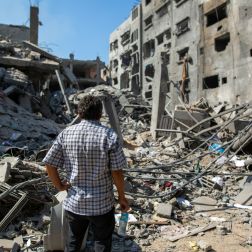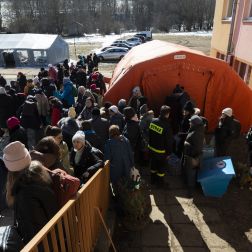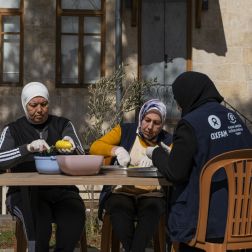- 5 mins read time
- Published: 19th April 2018
Mothers of Marawi hopeful after months of fear
Last year, residents of Marawi in the Philippines faced two major disasters: In May, they were uprooted by a violent siege and seven months later, they faced a deadly typhoon. Oxfam is supporting a consortium of local organizations who are helping families stay healthy and safe in the wake of these crises, rebuild their lives and prepare for future disasters. Nashima Potawan, 47, and her four children were forced to move to Madalum during the Marawi Siege, and months later faced the devastating effects of Typhoon Vinta. Mothers caught in conflict keeping their families safe.It is difficult for a mother to see her children in any kind of pain. The mothers of Marawi City, Philippines however, have witnessed their children endure crisis, only to be hit by another while still reeling and away from home. When single mother Nashima Potawan, 47, heard gunshots and bombings during the siege last spring, she immediately hurried each of her four children to different parts of their house. "I brought one of my children to the bathroom. Then, I held the youngest. I brought the other one to the living room and the other in the bedroom. So if ever a bomb would come, there will be survivors. Not all of us would die,” Nashima said. In another part of the city, Bailo Bazar comforted her three children who were shaking in fear. She was struggling to stop the youngest from crying. “My youngest child was crying, and my uncle said, ‘Stop him from crying. We must pretend that we are not at home so we should not be making noises.” While the women were struggling to take care of everything and everyone, members of the Maute Group were asking men and boys to come out of their homes and join the fighting. After a grueling day of waiting and hiding, both Nashima’s and Bailo’s families evacuated to Madalum, a nearby municipality, where many families stayed for months to stay safe. Natural disaster strikes As they approached their seventh month away from home, Typhoon Vinta struck just days before Christmas, leaving many casualties and millions worth of damage. Madalum, the newfound home of many families, including Nashima’s and Bailo’s, was one of the hardest hit, with landslides and flashfloods wiping out everything in its path. “I saw rocks and high levels of floodwater which were taller than an average person. My son said, “Mother, I am afraid.’ And I said, ‘We should endure this, because the flood will soon subside. Let’s wait until we can get out of here,” Nashima recalled. Then they saw just how quickly the water was rising, and she decided to bring her children to the gymnasium, which was later designated as an evacuation center for the typhoon survivors. “If I did not decide to go to the evacuation center, the floodwater would have risen immensely. It would have killed us,” Nashima said. Bailo’s family, on the other hand, was trapped on the roof of their house as the waters rose rapidly - She honestly thought that this time, they would not survive. Fortunately, the water did not reach their roof, and a few hours later, rescuers came and brought them to a safe place. Climate change and poverty add to risks, but local leaders are there to respond.
The Humanitarian Response Committee is working with Oxfam and the local government to support disaster-affected communities, and to help create and accurate database which will help future aid distributions. Even before the disasters struck, Nashima and Bailo belonged to already vulnerable communities, living in one of the poorest provinces in the country. In fact, according to the latest data from the Philippine Statistics Authority, seven out of ten families in province are poor and that number has been consistently rising. Without the resources to rebuild, Nashima and Bailo’s families were still living in the evacuation center one month after the storm, and eight months after the siege. Along with this growing poverty, climate change is putting island nations like the Philippines at increasing risk of flooding and weather-related crises. This means that there is more need than ever for local and national organizations who can step up and provide vital leadership to respond and prepare for future disasters. The Humanitarian Response Consortium (HRC) is a group of Filipino organizations that Oxfam helped found in 2010 to provide rapid, high-quality and dignified relief to disaster-affected communities. This past year, they supported families forced from their homes by conflict and natural disaster with access to safe water, latrines, shelter materials, communal kitchens, hygiene kits, and more. They also provided legal assistance to help people obtain IDs, which are crucial for safe travel and for accessing government benefits. Oxfam supported the HRC’s distribution of hygiene and kitchen essentials for more than 1,500 families, and emergency financial assistance to about 700 families. At times of disaster, HRC quickly assesses and responds to what communities need most in close coordination with government responders. They are helping local governments compile a complete and accurate database of the affected communities, so they can distribute further assistance for the typhoon survivors. This collaboration between organizations like Oxfam, these local organizations and government is key to provide the best possible resources and response for mothers like Nashima and Bailo, so they can rebuild their lives and feel better prepared to face future disasters as they arise.




